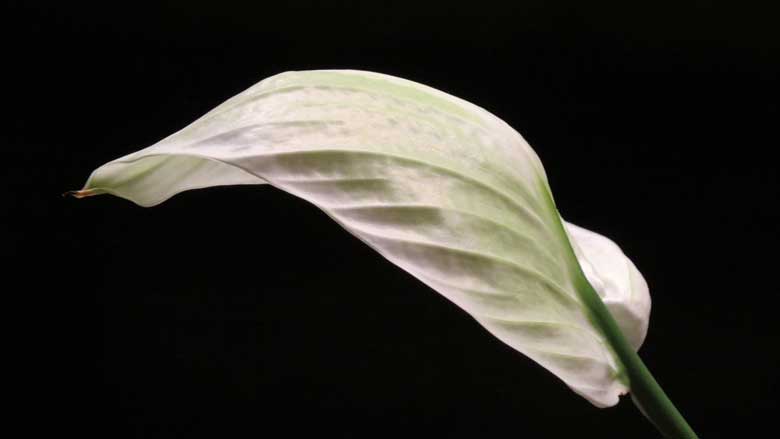Peace lily leaves can droop for various reasons. The primary cause is inconsistent watering, where either too much or too little water can lead to wilting. Additionally, exposure to too much direct light, drafts, temperature fluctuations, or low humidity levels can also cause the leaves to droop. Repotting with fresh soil and maintaining the right levels of water, light, and humidity can help revive a drooping peace lily.
If you’ve noticed that your Peace lily leaves are drooping, you’re probably wondering what’s causing it and how to address the issue.
This is a common problem with Peace lilies, and there are several potential causes. Let’s explore some of the most frequent reasons for drooping leaves on Peace lilies and provide solutions to rectify the problem
What Causes Peace Lily Leaves to Droop?
The Peace lily is a beautiful houseplant that’s generally easy to care for. However, even the Peace lily can encounter issues from time to time, and droopy leaves are one such problem.
A Peace Lily with drooping leaves indicates some unhappiness. So, what causes this flower and its foliage to droop?
There are a few reasons why a plant’s leaves may droop. Below, we’ll discuss some of the most common problems with Peace lilies that can lead to drooping leaves.
1. Underwatering
Peace lilies are a popular choice for indoor plants because they are relatively low-maintenance and can tolerate a wide range of light and humidity levels. They are also known to improve oxygen levels in the room.
However, Peace lilies will begin to droop if they are not watered regularly enough, as optimal soil moisture is key to their survival.
When the leaves droop, it is a sign that the Peace Lily is underwatered and the foliage is not receiving enough hydration.
The plant’s leaves are large and broad, making them especially susceptible to dehydration, which may cause peace lilies to droop more than other houseplants.
Peace lilies should be watered once a week and more frequently if the plant is placed in a warm or dry environment to prevent foliage from yellowing.
How To Fix It
If you notice your Peace Lily drooping, the first step is to check the soil for adequate moisture.
If the soil is dry, your plant is probably thirsty and in need of a good watering.
Water your Peace Lily plant until water begins draining from the bottom of the pot, ensuring the oxygen and water balance is maintained.
Make sure not to overwater, as this can also cause drooping, yellowing, and damage to the peace lily’s foliage.
Allow the potting soil to dry out slightly between waterings.
2. Overwatering
While Peace Lilies need to be watered regularly, it is also possible to overwater them, leading to peace lilies drooping and other signs of distress.
When Peace Lilies are overwatered, the leaves will begin to droop and turn yellow, indicating that the soil moisture is too high and the oxygen balance is disrupted.
Overwatering also negatively impacts the plant’s root system, making it difficult to uptake nutrients and water.
Check the soil if you suspect that your Peace Lily is being overwatered to ensure there’s no waterlogging.
If the soil is soggy or waterlogged, it’s time to take action.
How To Fix It
If you suspect your Peace Lily is overwatered, the best course of action is to refrain from watering for about a week and observe if the plant begins to recover.
If the soil is excessively waterlogged, consider repotting your plant using a fresh, dry soil mix to restore a proper soil moisture balance.
Select a well-draining pot and appropriate potting mix, as Peace Lilies are averse to having soggy roots.
To ensure adequate drainage, opt for a pot with a hole at the bottom. This will facilitate the release of excess water and prevent the Peace Lily’s roots from becoming overly saturated.
3. Too Much Sunlight
Peace Lilies are native to the shady rainforests of Central and South America, so they are not used to direct sunlight.
They thrive in indirect bright light or low light conditions. If Peace Lily leaves are exposed to too much sunlight, they will begin to droop as both the flower and foliage are not suited to high light intensities.
The leaves, full of moisture, are not equipped to deal with direct sunlight’s intense heat and light, which may lead to drooping, yellowing, and eventually to drop.
The Peace Lily plant will attempt to compensate for this by closing its leaves, which only provides partial protection.
Over time, the leaves will become scorched and may eventually fall off.
How To Fix It
If your Peace Lily is drooping because of too much sunlight, the best solution is to move it to a shadier spot.
Find an area where it will only receive indirect light, and the foliage can recover and regain its healthy, vibrant green hue. You can also try draping a sheer curtain over the plant to filter out some of the strong lighting – a common gardening tip for caring for houseplants.
Indoors, Peace lilies do best near an east- or west-facing window.
4. Low Humidity
Peace lilies are tropical plants – valued houseplants among gardening enthusiasts, so they prefer humid environments. However, they are quite adaptable, even tolerating spaces with indirect lighting.
They need a relative humidity of at least 50% to survive. Look out for dry edges on the leaves, which could be a sign of too little moisture.
If your home has low humidity levels, the leaves will begin to droop in an attempt to conserve moisture.
The Peace lily will also produce fewer flowers in low-humidity environments, making them less attractive to bugs and insects.
You can tell that your plant is not getting enough humidity if the leaves are drooping and the flowers are wilting. In extreme cases, it’s common for the edges of the leaves to turn brown.
If your Peace lily is not getting enough humidity, you can do a few things to increase the moisture around it.
How To Fix It
One option is to mist the plant with water every day – a simple yet effective gardening hack for maintaining humidity-deficient houseplants.
You can also try placing the Peace lily on a pebble tray or humidifier.
By creating a more humid climate in your home through the use of a pebble tray, humidifier, or other methods, you can help maintain humidity-deficient houseplants, such as the Peace lily, and ensure they thrive in their environment.
5. Temperature Stress
Peace lilies are tropical plants, so they prefer warm temperatures. They appreciate good lighting but should be away from direct sunlight.
They will not tolerate cold drafts or temperatures below 60 degrees Fahrenheit. Avoid placing your Peace Lily near exits and entrances where drafts may hit it.
If the temperature around your Peace lily drops too low, the leaves will begin to droop and turn brown. This typically happens along the edges first.
When Peace lilies are exposed to colder temperatures, their leaves droop to prevent them from losing too much water. This shows the plant’s exceptional resilience against harsh conditions.
On the other hand, Peace lilies can also be stressed by too much heat, leading to bugs being attracted to the weakened plant.
If the temperature gets too high, the Peace lily leaves will start turning yellow and droop. This is because the plant is trying to prevent itself from losing too much water.
When the temperature is hot, the air is dry, and the plant will lose moisture through its leaves. It’s essential to keep it in a cool spot with proper lighting and ample water supply.
To prevent this from happening, the Peace lily will restrict water flow to its leaves, causing them to droop.
How To Fix It
If your Peace lily is drooping because of temperature stress, you need to move it to a location where the temperature is more stable.
Place your plant near a heat source if the temperature drops too low.
If the temperature gets too high, you can try moving the Peace lily to a cooler spot or placing it in a room with air conditioning.
Peace lilies do not tolerate extreme temperature changes, so it is best to keep them in a location where the temperature is relatively stable.
6. Pest Infestation
While they are easy to care for, Peace lily plants can sometimes suffer from pest infestations.
Take care in checking your houseplants regularly for these bugs to catch and deal with the problem promptly.
One of the most common signs of a pest problem is drooping leaves.
Peace lily leaves typically droop when eaten by pests such as aphids or mealybugs.
These insects feed on the plant’s sap, causing the leaves to wilt and turn yellow.
In severe cases, an infestation can kill a Peace lily. Bugs can also introduce diseases to plants, which can also cause the leaves to droop significantly.
How To Fix It
If your Peace lily is infested with pests, the best solution is to treat it with neam oil or insecticidal soap.
These products will kill the pests without harming your plant.
You can also try to remove the pests by hand with a cotton swab dipped in rubbing alcohol.
If you see aphids on your Peace lily, you can try spraying them with water to knock them off.
You can also try to attract beneficial insects to your Peace lily by planting companion plants such as marigolds or dill.
These plants will help to keep the pests under control.
7. Nutrient Deficiencies
Peace lilies are susceptible to nutrient deficiencies, which can cause drooping leaves.
The most common nutrient deficiency in Peace lilies is a lack of nitrogen.
Nitrogen is an essential plant nutrient responsible for the growth of the leaves.
If your Peace lily does not have enough nitrogen, the leaves will turn yellow and droop.
They can also suffer from deficiencies in other nutrients, such as phosphorus and potassium. These deficiencies can also cause drooping leaves.
How To Fix It
The best way to fix a nutrient deficiency is to fertilize your Peace lily with a balanced fertilizer. Watch out for the white roots in the root ball. Your goal is to keep them healthy.
Use a fertilizer that is high in nitrogen for the best results. But be careful not to over-fertilize your Peace lily, as this can cause the leaves to burn.
You can also try adding compost to your Peace Lily’s potting mix to help provide additional nutrients. Incorporating compost into the soil can boost the health of the root ball and also improve the condition of the leaves.
8. Transplant Shock
Transplant shock is a common problem with Peace lilies.
It occurs when a Peace lily is moved from one location to another and cannot adjust to its new environment. In a garden scenario, moving a plant from indoors to the outdoor setting can cause shock.
Peace lilies are especially susceptible to transplant shock when they are moved outdoors.
When a Peace lily is transplanted, the roots are disturbed, and the plant will shock.
When a plant is subjected to transplant shock, its leaves will droop in an attempt to conserve energy.
The Peace lily may also lose some of its leaves in some cases. This often leads to a white, bare appearance.
How To Fix It
If your Peace lily is drooping because of transplant shock, the best solution is to give it time to adjust to its new environment. Being patient and allowing the plant to acclimate can do wonders for Peace Lily’s health.
The plant will eventually recover from the shock, and the leaves will stop drooping.
You can help the Peace lily to recover from transplant shock by placing it in a location where it will receive bright indirect light. Ensure the location also has access to sufficient drainage holes to prevent overwatering.
You should not water your Peace lily for the first week after transplanting it.
After the first week, you can resume watering your plant as usual.
Do not fertilize the Peace lily until it has recovered from transplant shock.
9. Root Rot
Root rot is a common problem with Peace lilies.
Peace lily’s roots can rot if exposed to excessive moisture. This can happen if the Peace lily is overwatered or the potting mix does not drain well.
When the roots of the plant are exposed to excessive moisture, they will begin to rot.
Root rot can cause Peace lily leaves to turn brown and droop. In severe cases, root rot can kill a plant.
Other common Peace Lily root rot symptoms include yellow leaves, wilting, and stunted growth.
How To Fix It
If your Peace lily has root rot, the best solution is to repot it in fresh potting mix.
Trim away any roots that are black or mushy.
Be sure to use a potting mix that drains well. To improve drainage, you can also add perlite or sand to the potting mix.
Once you have repotted your lily, water it only when the potting mix is dry.
Only fertilize your Peace lily once it has recovered from root rot.
How To Prevent Peace Lily Leaves From Drooping?
Peace lilies are beautiful, low-maintenance plants that thrive indoors. However, even the most experienced Peace lily growers may notice their leaves drooping from time to time.
While this is usually nothing to worry about, you can do a few things to prevent a droopy Peace lily in the future.
- Make sure your Peace lily is getting enough light. Peace lilies prefer indirect sunlight, so if the leaves droop, try moving your plant to a brighter spot. Avoid placing your Peace lily in direct sunlight, as it can cause the leaves to scorch.
- Water your Peace lily regularly. Peace lilies like to be kept moist but not soggy—water your plant when the top inch of soil feels dry.
- Fertilize your Peace lily during the growing season, typically in the spring and summer months. Use a balanced, water-soluble fertilizer diluted to half-strength.
- Check the temperature and humidity of your Peace lily’s environment. Peace lilies prefer warm, humid conditions. If your home is particularly dry, try placing your plant on a pebble tray or misting it with water a few times a week.
- Avoid sudden changes in the environment. Peace lilies are sensitive to changes in temperature and light. When moving your plant, do so gradually to allow it to adjust to its new surroundings.
Prevention is the best cure when it comes to Peace lily drooping. By following the tips above, you can keep your Peace lily healthy and prevent its leaves from drooping in the future.
Final Thoughts
The Spathiphyllum, commonly known as the Peace lily, is a beautiful, low-maintenance indoor plant that can thrive with minimal care as long as it is provided with adequate light, water, and humidity, and its leaves are regularly misted to prevent them from drooping in the future.
However, even the most experienced plant growers may notice their leaves drooping from time to time.
There are several reasons why your Peace lily leaves might be drooping, but thankfully, there are also some solutions.
By understanding the cause of the problem, you can take steps to fix it and get your Peace lily back to its healthy self.







